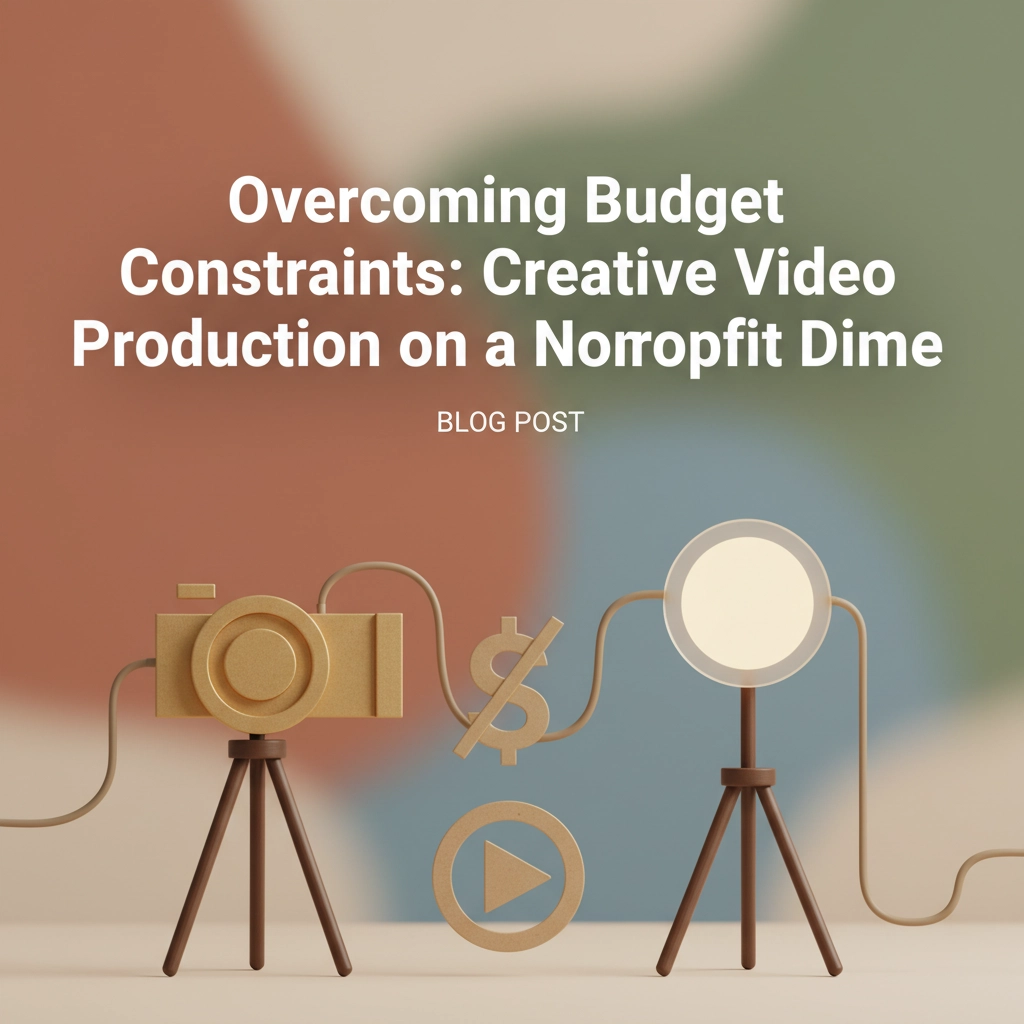Overcoming Budget Constraints: Creative Video Production on a Nonprofit Dime

Let's be real about something: if you're running a nonprofit in Ontario, your budget probably makes a shoestring look extravagant. You've got a mission that could change the world, but your bank account is reminding you that professional video production costs can run anywhere from $5,000 to $21,000 for a single 2-3 minute video.
Here's the good news: you don't need Hollywood budgets to tell compelling stories that drive donations and engagement. Some of Ontario's most successful nonprofits have mastered the art of creating powerful video content without breaking the bank. Let's dive into how they do it (and how you can too).
Start With Strategic Planning (It's Free and It's Everything)
The biggest money-waster in video production? Poor planning. When Toronto's Daily Bread Food Bank creates their annual impact videos, they don't just wing it: they plan every shot, every interview, and every location detail months in advance. This approach keeps their pre-production costs under $3,000, even for videos that reach millions of people.
Your planning phase should answer three crucial questions: What's your core message? Who needs to hear it? Where will they see it? Once you nail these down, everything else becomes clearer and cheaper.
Scout your locations at different times of day. That community center might look perfect at 2 PM, but what about during your actual shoot time? Natural lighting can save you hundreds in equipment costs, but only if you know when and where it works best. Pro tip: bring your phone and take test shots during your scout: you'll thank yourself later.

Your Team Is Your Goldmine
Here's something that might surprise you: some of your best video talent is probably already on your payroll. That program coordinator who's great with kids? Perfect for interviewing young beneficiaries. Your communications person who writes killer social media posts? They've probably got the storytelling chops for scriptwriting.
The Canadian Cancer Society's Ontario chapters regularly use staff members as on-camera hosts for their educational content. It's authentic, cost-effective, and actually builds stronger connections with their audience. People want to see the real faces behind your mission, not polished actors.
Don't overlook your volunteer base either. You'd be amazed how many supporters have day jobs in creative fields. That volunteer who helps with your fundraising events might be a freelance graphic designer, or your board member's spouse could be a retired teacher who's natural in front of cameras.
Equipment: Rent Smart, Buy Smarter
Forget about owning a Red camera setup. What you need is gear that gets the job done without emptying your reserves for actual program delivery.
For most nonprofit videos, a decent DSLR camera (you can rent one for about $200-300 for a weekend) paired with a simple lighting kit will get you 80% of the way to professional quality. Hamilton's Mission Services regularly produces compelling donor stories using rented equipment and natural lighting: their secret weapon is focusing on authentic moments rather than technical perfection.
If you're planning multiple videos throughout the year, consider investing in basic equipment: a good microphone (audio quality makes or breaks video content), a sturdy tripod, and some reflectors for lighting control. These tools will serve you for years and pay for themselves after just a few projects.

Creative Alternatives That Actually Work
Sometimes the best solution isn't traditional video at all. Ottawa's Boys and Girls Club has seen huge success with animated explainer videos that cost a fraction of live-action shoots. These work especially well for complex topics like program impacts or policy issues.
Screen recordings with voiceovers can be incredibly powerful for educational content. If your nonprofit offers training or resources, you can create valuable content using nothing but screen recording software and a decent microphone. The Centre for Addiction and Mental Health in Toronto uses this approach for their online training modules.
Consider documentary-style approaches too. Instead of scripted scenes, follow your programs in action. Real moments of impact often resonate more than produced scenarios, and they're much cheaper to capture. Just make sure you have proper consent forms: especially important when working with vulnerable populations.
Smart Scheduling Saves Money
Here's where many nonprofits blow their budgets: inefficient production schedules. Professional crews charge daily rates that can reach $5,000-9,000 per day. The key is maximizing what you accomplish in minimal time.
Batch your content creation. If you need donor testimonials, interview several people in one day. If you're showcasing different programs, film multiple segments during one production day rather than spreading shoots across weeks.
The United Way of Greater Toronto masters this approach. They'll often dedicate one intensive day to capturing content for their entire quarterly campaign: multiple interviews, B-roll footage, and even different seasonal variations of the same message.

Post-Production on a Budget
Editing is where your story comes together, but it doesn't have to drain your resources. At roughly $500-1,000 per finished minute, professional editing adds up quickly. However, many nonprofits are discovering they can handle basic editing in-house.
Software like DaVinci Resolve is completely free and surprisingly powerful. Your communications team member who's comfortable with social media tools can likely learn video editing basics through YouTube tutorials. For more complex projects, consider partnering with local colleges: film students often need portfolio projects and work for reasonable rates.
Keep your edits simple and focused. The most powerful nonprofit videos often use minimal effects, letting the authentic stories shine through. Think of it as storytelling, not technical wizardry.
Building Strategic Partnerships
This is where Ontario nonprofits really shine. The collaborative spirit in our nonprofit sector creates incredible opportunities for cost-sharing and resource pooling.
Partner with complementary organizations for joint projects. If you're focused on youth services and another nonprofit handles family support, a collaborative video about community impact serves both missions while splitting costs.
Local businesses often provide in-kind support for video projects, especially if you offer recognition in your content. That doesn't mean turning your video into a commercial: but a simple "thanks to XYZ Company for supporting this project" can unlock equipment, locations, or even professional services.
Film schools and media programs across Ontario constantly need real-world projects for their students. Seneca College, Ryerson University (now Toronto Metropolitan University), and other institutions have produced high-quality content for nonprofits as part of their curricula. Students get portfolio pieces, you get professional-quality work at student-friendly rates.
The Reality Check: Where to Spend vs. Where to Save
Let's get practical about budget allocation. Save money on fancy graphics and complex animations: spend it on good audio equipment and proper lighting. People will forgive slightly shaky footage, but poor audio will have them clicking away faster than you can say "donate now."
Invest in professional help for scripting if storytelling isn't your strength. A well-crafted script can turn a modest production into compelling content, while a poor script can make even expensive footage fall flat.
Don't skimp on legal considerations either. Proper release forms and music licensing might seem like boring expenses, but they prevent expensive problems later. Use royalty-free music libraries or work with local musicians who might donate original music in exchange for exposure.

Making Every Dollar Count
The most successful nonprofit videos share one thing: they focus relentlessly on their core message. When budget forces you to strip away everything non-essential, you often end up with more powerful content.
Your donor doesn't need to see fancy transitions: they need to understand your impact. Your community doesn't require Hollywood production values: they need to feel connected to your mission. Keep that perspective, and your budget constraints become creative catalysts rather than barriers.
Remember, authenticity resonates more than production value. Some of the most viral nonprofit content comes from smartphones and genuine moments, not expensive equipment. Your mission is already compelling: video just helps you share it more effectively.
Ready to turn your video vision into reality without emptying your program funds? Let's talk about creating content that moves hearts, minds, and wallets while respecting your budget realities. Get in touch with us and let's explore how to maximize your impact, one frame at a time.
